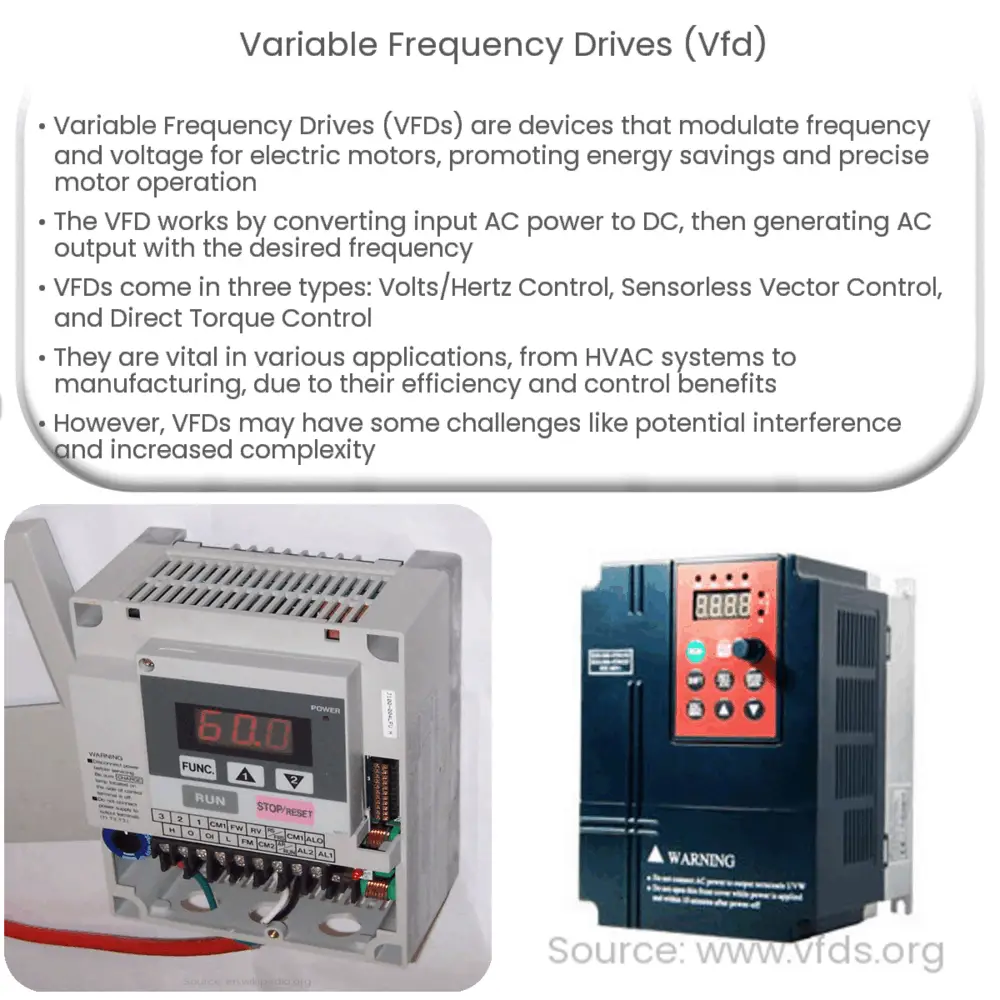Explore the basics of Variable Frequency Drives (VFDs), their operation, types, components, applications, and technical considerations for effective motor control.

Understanding Variable Frequency Drives (VFD)
Variable Frequency Drives (VFDs), also referred to as Adjustable Speed Drives or Inverter Drives, are devices used primarily in motor control to modulate the frequency and voltage delivered to electric motors. Their primary function is to facilitate energy savings and fine-tune the operation of motor-driven equipment.
The Principle of VFD Operation
The basis of VFD operation is quite straightforward. An electric motor’s speed is proportional to the supplied frequency. Therefore, to control the motor’s speed, we alter the frequency. A VFD does this by converting the input power (usually AC) to DC and then recreating an AC output with the desired frequency and voltage. The result is precision control over the speed and torque of the motor.
Types of Variable Frequency Drives
VFDs are categorized into three main types based on the control method employed:
- Volts/Hertz Control (V/Hz): This is the most common type, suitable for general applications. In this VFD, the ratio of voltage to frequency is kept constant to maintain motor torque.
- Sensorless Vector Control (SVC): This offers better motor control compared to V/Hz drives. It decouples motor flux and torque production, improving performance, but does not provide actual motor shaft speed control.
- Direct Torque Control (DTC): This VFD type offers the best motor control. It directly controls motor variables like torque and flux and provides actual motor shaft speed control. However, it is more complex and expensive.
Components of a VFD
While a VFD might seem complex, it is essentially made up of three core components:
- The Converter: This first stage of the VFD uses a rectifier circuit (usually made up of six diodes) to convert incoming AC power into DC power.
- The DC Bus: This component stores the DC energy produced by the converter. It typically includes a filter (made of capacitors and inductors) to smooth out the rectified DC waveform.
- The Inverter: The final component in a VFD, it uses a series of switches (typically power transistors) to convert the DC power back into AC power at the desired frequency.
Applications of VFDs
VFDs are widely used in industrial, commercial, and domestic applications due to their energy-saving potential and precise control over motor speed. They find use in HVAC systems, water/wastewater treatment facilities, oil and gas operations, and manufacturing processes, among others.
With this understanding of what VFDs are, how they work, their types, components, and applications, we can now delve into the technical specifications, installation considerations, and advantages and disadvantages of using VFDs. That will be the focus of the second part of this article.
Technical Specifications of VFDs
When selecting a VFD, it’s crucial to consider a range of technical specifications. They include:
- Voltage Ratings: This should align with the system’s operational voltage. Common voltages include 200-240V, 380-480V, and 500-600V.
- Current Ratings: The VFD’s current rating should exceed the motor’s full-load ampere rating to accommodate peak loads.
- Motor Power (HP or kW): This specification should correspond to the motor’s power rating.
Installation Considerations
VFD installation involves several considerations to ensure optimal operation and longevity. These include:
- Environmental Conditions: Temperature, humidity, and dust levels can affect VFD performance and lifespan.
- Electrical Requirements: Adequate electrical supply and proper grounding are essential.
- Physical Location: Adequate ventilation and accessibility for maintenance are important factors.
Advantages and Disadvantages of VFDs
VFDs come with a host of advantages:
- Energy savings due to improved efficiency
- Reduced wear and tear on motor components, leading to extended equipment life
- Improved process control by fine-tuning motor speed and torque
Despite their benefits, VFDs have some disadvantages:
- Potential to generate electrical and radio frequency interference
- Increased complexity compared to direct-on-line starters
- May require additional protective measures in extreme environments
Conclusion
In summary, Variable Frequency Drives are vital devices in the realm of motor control, enabling energy savings and precise operation of motor-driven equipment. By understanding their working principle, types, components, and applications, as well as key technical specifications and installation considerations, users can harness the full potential of VFDs. Despite some drawbacks, the benefits of using VFDs — including improved efficiency, enhanced process control, and extended equipment life — make them an invaluable tool in various industrial, commercial, and domestic applications. Their growing adoption and ongoing advancements only highlight their importance in an increasingly energy-conscious world.

